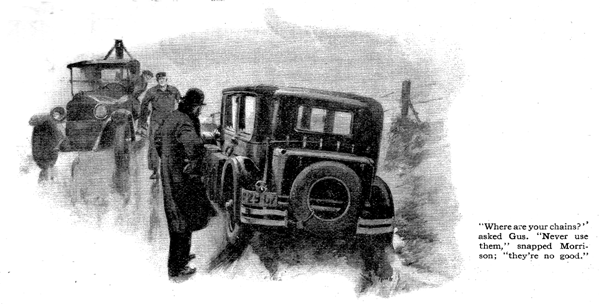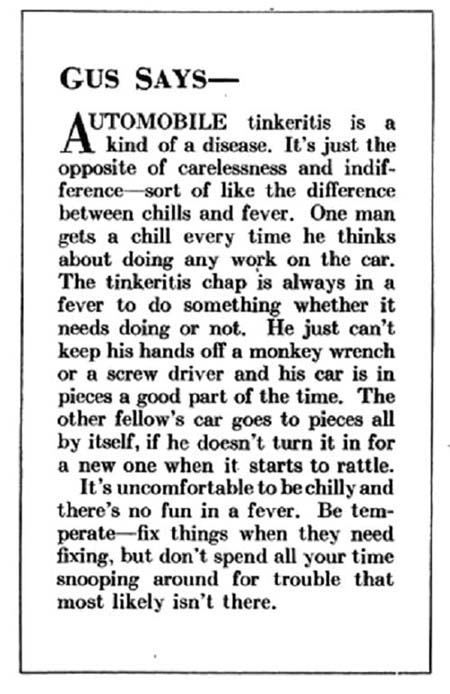March 1930
Gus
Explains
WHY TIRE CHAINS ARE SAFEST
by Martin Bunn
And Demonstrates The Point by Using Them to Pull the Car
of an Unbelieving Motorist Out of the Mud

"I've been expecting a call like this from Morrison, "Gus Wilson grumbled to his partner, Joe Clark, as they stopped the Model Garage service car beside an expensive new coach job that was stuck in the mud.
"Where are your chains, Mr. Morrison?" asked Gus, as he noticed the position of the stuck car.
"Never use 'em," snapped Morrison, "they're no good."
Gus said nothing. Previous experience with Morrison had shown him the futility of arguing with an obstinate, opinionated rich man. Instead, the veteran auto mechanic dug around in the back of the service car and pulled out a pair of chains big enough to go around Morrison's tires.
"So you don't believe in chains, Mr. Morrison," he remarked. "Now just watch what chains will do for your car."
One rear wheel of the car still remained on the concrete of the highway but rested on a smooth coating of ice. The other wheel had sunk several inches into a bog of half frozen mud at the edge of the road.
Gus stretched one of the chains on the ice-covered pavement in front of the up wheel and hooked the end nearest the tread over the tire and around one of the spokes.
"Watch it now, Joe," he said as he got into the car and let the clutch in gently. The wheel in the mud remained stationary, but the other started to turn, pulling the chain toward it along the ice until a cross link caught under the tread. The links bit into the ice and stopped the wheel from slipping. The bogged wheel started to churn in the mud, but, as the tire had a good tread and the mud, had a relatively solid bottom, the car crept forward rolling onto the chain. By the time the chain was completely around the tire the car was almost back on the road.
"Well, what do you know about that?" exclaimed Morrison in amazement. "I thought all the time that the wheel in the mud was doing the slipping."
"It all depends on the kind of mud," Gus explained. "If there wasn't any ice on the road and the car got stuck you could be pretty sure the wheel was bogged in one in one of those soupy mixtures that simply won't give any traction. In that case this stunt wouldn't work. You'd have to put the chain on the wheel in the mud."
"It's funny I never seem to have any luck with chains," Morrison puzzled. "I got into a beautiful skid with chains on once, so I decided they weren't any good."
"Chains do act queer at times," admitted Gus. "Trouble is, people think that with chains on, the wheels simply can't slide, so they jam on the brakes too suddenly or try to go round corners too fast. If you happen to lock the wheels at a point where there isn't any cross chain in contact with the pavement the wheels will slide on the rubber in grand style; but there's lots of going where can't navigate at all unless you do have chains. Of course, though, you can get along on wet pavements without 'em especially if you let a little air out of your tires.
"Seems to me," Gus continued, "that the cost of a pair of chains is so small that it isn't worth risking an expensive car without 'em. Every car owner ought to have a pair of chains parked under the back seat.
"A fellow I know didn't believe in chains and he went on a long trip in summer without 'em. One day he got caught in a terrible downpour of rain and he had to make a detour from the main road. He met another car coming the other way that bogged more than half the road. The fellow that didn't like chains got stuck in some deep mud and stayed there until he hired a farmer with a team of horses to pull him out. If he'd had chains along he'd have saved at least twice what they cost him."
"H'mm," grunted Morrison, "I hadn't looked at it just that way. The darn things are so noisy and wear out so quick I kind of hate to bother with them."
"You can keep down the noise, "said Gus, "by using the spring tighteners, but you don't want to get them so tight they don't move on the tires, or they'll cut through the tread in no time. As for wearing out it's a good hunch to put 'em on the other side out every time you apply 'em. You can got double the wear that way because when you turn 'em over the wear comes at a different point on the link."
"Well, "Morrison said as he climbed into his car. "I suppose now you'll try to sell me another pair to put on the front wheels."
Gus laughed, "No, I hardly think chains on the front wheels are worth while these days, when the tires are so large, though it depends a lot on the car. I saw a dumbbell the other day driving one of those new front-drive cars and he had the chains on the rear wheels. That would be just as foolish as for you to put chains on the front wheels and leave the rear wheels bare."
"What would you have done if you hadn't any chains that fitted my car?" Morrison asked.
"I'd have hooked on the service wagon and pulled you out," said Gus. "That's the easiest way. I only used the chains to convince you they were good dope. There are lots of ways to get a car out of a mud hole. The main thing is to remember that the two wheels can turn independently so there's not use in doing anything to the wheel that is stuck in the mud unless the other wheel is on dry ground. If both of 'em are stuck, then whatever you do to one wheel has to be done to the other wheel, too. Sometimes you can get out of a mud hole by putting the brakes on a bit. That only works if the brake on the side that's stuck holds a little tighter than the one on the pavement."
"Why wouldn't it be a good idea just to carry some pieces of rope in the car and wrap 'em around the tires when you get stuck?" Morrison asked.
"That would work all right in mud or deep snow," Gus replied, "but it wouldn't be much good on ice." Nothing is any good on ice unless it'll cut in the way chains do. Of course, if you're going to do a lot of touring in a country where you are likely to get stuck in mud up to the hub caps every so often, it's a mighty good plan to take along enough rope to give you a chance to use a block and tackle. If all four wheels get bogged in real soggy mud the easiest way to get the car out is to hook up a block and tackle to the frame, with the other end lashed to a tree or a stake driven into the ground, and just haul away until you pull the car through."
"Thank goodness, I don't have to do any touring like that," said Morrison. "Put on the other chain and stick the pair on my bill."
END
L. Osbone 2019
